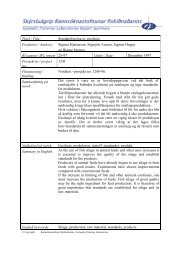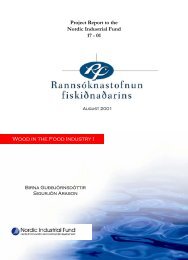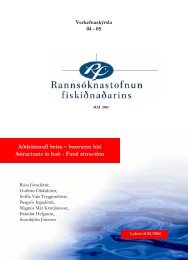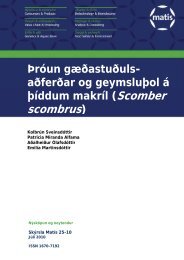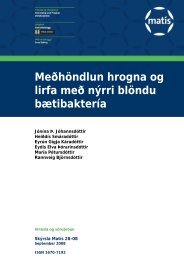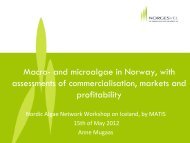Microbiology and Spoilage Trail in Nile Perch (Lates niloticus), Lake ...
Microbiology and Spoilage Trail in Nile Perch (Lates niloticus), Lake ...
Microbiology and Spoilage Trail in Nile Perch (Lates niloticus), Lake ...
You also want an ePaper? Increase the reach of your titles
YUMPU automatically turns print PDFs into web optimized ePapers that Google loves.
The excellent freshness fish grade (QIM score) was scored dur<strong>in</strong>g 15 days <strong>and</strong> good quality<br />
fish were scored dur<strong>in</strong>g 3-4 weeks of storage <strong>in</strong> ice. QIM scores characterized with a<br />
constant <strong>in</strong>crease (from 2-14 score) through out the 33 days storage time (figure 4). The<br />
quality of fish after 3 weeks of storage <strong>in</strong> ice was observed <strong>and</strong> was graded as not fit for<br />
process<strong>in</strong>g prime quality fresh chilled fillets for export.<br />
Figure 4: QIM score for whole <strong>Nile</strong><br />
perch dur<strong>in</strong>g storage <strong>in</strong> ice.<br />
4.2.1.2 Microbiological analysis<br />
44<br />
Figure 5: Ma<strong>in</strong> contribut<strong>in</strong>g attributes<br />
to QIM score for whole <strong>Nile</strong> perch<br />
dur<strong>in</strong>g storage <strong>in</strong> ice, (GA: General<br />
appearance).<br />
The test results for specific spoilage organisms (SSO), total viable counts (TVC) <strong>and</strong><br />
Enterobacteriaceae counts for Laboratory iced whole <strong>Nile</strong> perch stored <strong>in</strong> ice at 0-3 o C are<br />
shown <strong>in</strong> figure 6. The SSO counts were low up to 4 th day of storage <strong>in</strong> ice <strong>and</strong> then rapidily<br />
<strong>in</strong>creased from 2.75 - 6.15 log10 cfu/g after 15 days of storage. Similary the TVC counts<br />
were low but higher than the SSO counts on the 4 th day of storage but <strong>in</strong>creased from 4.12 -<br />
7.88 log10 cfu/g after 15 days of storage. The Enterobacteriaceae counts were similar to<br />
TVC counts after 4 days of storage i.e. 4.40log10 cfu/g <strong>and</strong> <strong>in</strong>creased up to 6.22 log10 cfu/g<br />
after 15 days of storage. These counts corresponded well to the excellent freshness quality<br />
scores for the same period of whole <strong>Nile</strong> perch for process<strong>in</strong>g <strong>in</strong>to very good quality fillets<br />
<strong>and</strong> or other products. After 15 days of storage <strong>and</strong> up to 22 days of storage of whole <strong>Nile</strong><br />
perch <strong>in</strong> ice all microbiological counts slowly <strong>in</strong>creased to 9.49log10cfu/g (SSO);<br />
9.84log10cfu/g (TVC) <strong>and</strong> 8.22log10cfu/g (Enterobacteriaceae). Then the counts <strong>in</strong>creased up<br />
to a stationary phase dur<strong>in</strong>g the fourth <strong>and</strong> fifth weeks of storage <strong>and</strong> reached maximum




